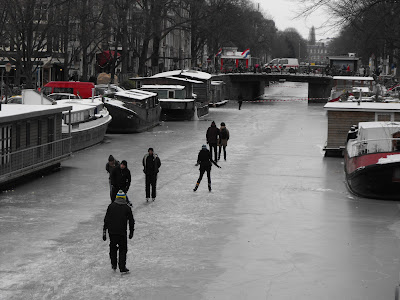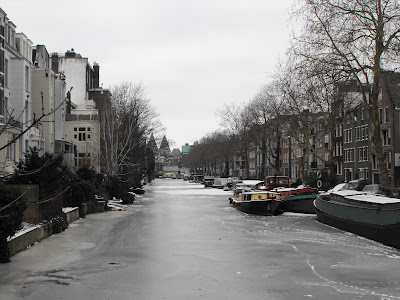Den Haag, on the coast south west of Amsterdam in the Netherlands, is the seat of the Dutch Government, the home of the Royal Family, and was until 1806, the capital of the Orange nation.
Boasting stunning architecture, wide tree-lined avenues, sociable town squares, hidden parks, canals, a myriad of restaurants, the UN, and a long sandy beach, it would seem this treasured little city has everything for the discerning visitor. In the winter however, despite all the above boxes being ticked, there is definitely something missing in the cosmopolitan streets of this centre of European activity.
Travelling by train from Amsterdam takes but forty five minutes, and Dutch trains being Dutch, they are on time, fast and ridiculously practical. Two floors of seating means there is none of that British style fuss over someone sitting in “your” allocated seat. The views from the train are quintessentially Dutch too; flat pasture land stretches far into the distance, dissected evenly by deliberately straight and perpendicular irrigation channels. The only breaks in this vista of man-made countryside are clapperboard windmills evoking romantic visions of a historical rural existence in these windswept flat lands. Thoroughly drawn back into the past world of Van Gogh’s romantic idyll one arrives in Den Haag with a comfortable grin and a slight reluctance at being thrust back into modern city life. This reticence is short lived however as the tram into the small centre provides stunning views of The Hague’s most famous building, The Binnenhof. By the time you step off the number 17, you are aware that this is a slower paced metropolis than Amsterdam, and will afford you enjoying city life, at a country pace.
 |
| The Binnenhof |
Arriving at 9am on a Tuesday I expected to be met with the hustle and bustle of shops opening and people rushing around to their world government, or banking positions in this hub of European business and politics. I was pleasantly disappointed to find that its grand avenues were very quiet. Apparently shops in Den Haag don’t open until eleven at the earliest, and people are far more relaxed about their approach to being “on time”. I could almost feel London city suit types beginning to smoke from the ears with the thought that people didn’t arrive in offices at 5am and not leave until after 10pm at night!
I spent two cold February days in Den Haag. The old city centre has lovely small back streets. Crammed tightly with old book shops and antiques they are reminiscent of J.K. Rowlings magic streets in Harry Potter. I would not have been surprised to find little wizards purchasing their first wands from the multitude of old bearded men and wizened old ladies, marshalling their collection of curios and antique till registers with kindly smiles.
Even the stunning UN complex was at peace. The famous blue flag waved proudly in front of its grand Gothic home, and the World Peace Flame flickered silently outside the gates, while inside I imagined a buzz of activity in this time of huge unrest and difficulty throughout the world.
 |
| Wide Streets of Den Haag |
 |
| The UN Flag |
Den Haag is also famous for its beach, Scheveningen. In the summer thousands of Netherlanders flock to the resorts golden sands and seafood cafe’s, marking it as one of Holland’s most loved holiday destinations. This was not the case on a cold February Wednesday however. The sands were golden indeed, and provided a kind of desolate beauty in their emptiness, but the promenade was deserted, with flimsy hand written signs blown over by the strong northerly wind, rusty fairground rides lying empty and lacking in squeals of childish delight, and huge swathes of bike racks missing their bikes. Scheveningen in the summer may be the centre of tourist life, but in the winter the final tram stop at the end of the beach feels a lot like the end of the universe, and its apocalyptic greyness only adds to its beautiful desolation.
 |
| Lonely Bike Racks |
 |
| Scheveningen |
 |
| Desolate Promenade |
The city of Den Haag is pretty and approachable and its beach in winter has an empty attraction. Despite many recommendations to visit in summer I found the wintry promenade beautiful in a lonely contended way and this is how I will fondly remember it. Den Haag’s difference to Amsterdam is the pride of its locals; their trams are red, not blue, their streets are wide, not narrow, and their restaurant seating stays outside, even in winter. Although all the tourist shops I saw paraded postcards of a sun drenched city bedecked in flowers, the February Den Haag I experienced was quietly going about its private life before the tourists of summer arrived. At first its peace and quiet was refreshing, but after a while there was a realisation that everywhere in Den Haag in winter is very very, very quiet. It did have an empty beauty to it, but it missed a sense of atmosphere, a sense of personality warmth. I am charmed enough however to give it a second chance, and will return in the summer to see if the postcard pictures really are true.



